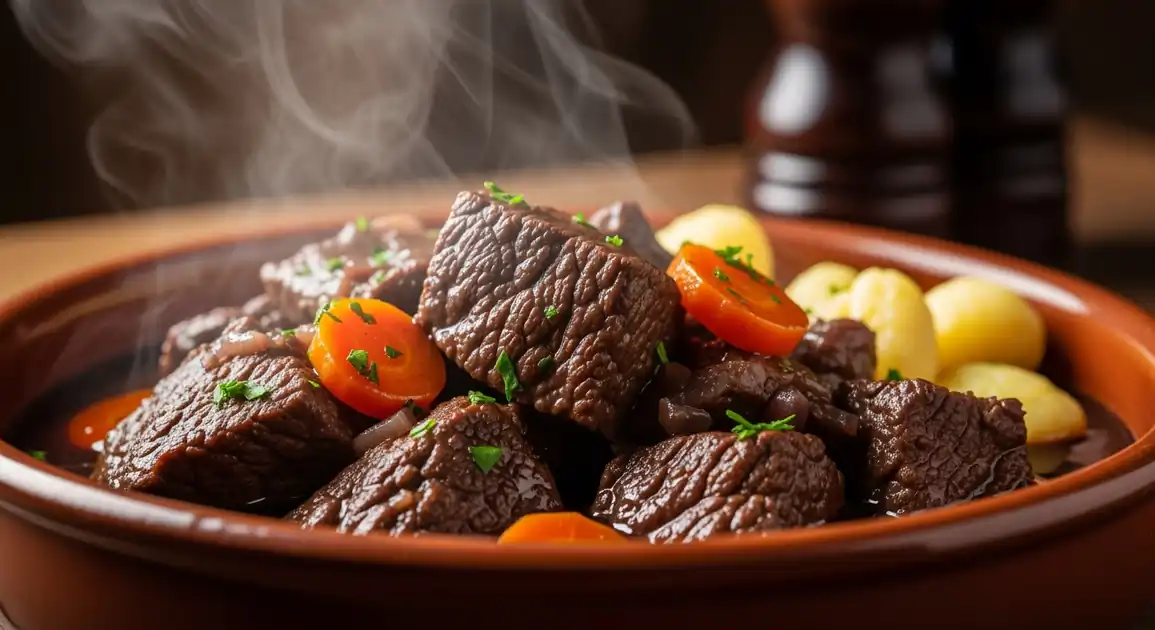Daube Provençale (Provençal Beef Stew)
Daube Provençale

Description
In Marseille, Daube Provençale is a beloved local staple, readily available in many traditional restaurants and bistros, particularly in older neighborhoods like Le Panier and around the Vieux Port. It embodies the hearty, flavorful cuisine of the city and its Provençal roots.
Dietary Information
Serving information
Serving style
Typically served hot in a bowl with pasta (often tagliatelle) or gnocchi. Crusty bread is always provided. Portions are usually generous.
Quick facts
Lunch: 12 PM - 2:30 PM. Dinner: 7:30 PM - 10:30 PM (some places open earlier or close later).
Safety Tips
What to Look For
-
Served piping hot
Ensures the stew has been held and served at a safe temperature, minimizing bacterial risk. Stews should be visibly steaming.
-
Reputable establishment (Bistro/Restaurant)
Choose places known for traditional French cuisine or with good local reviews. Avoid questionable tourist traps.
-
Rich, savory aroma
A good Daube smells deeply of wine, herbs, and beef. Any sour, metallic, or 'off' smells are red flags.
-
Beef is extremely tender
While more a sign of quality, properly slow-cooked meat reaches temperatures ensuring safety. Tough meat might indicate rushed cooking.
What to avoid
-
Stew served lukewarm or cool
Indicates improper holding temperature, a significant food safety risk for pre-cooked dishes.
-
Visible signs of poor hygiene in the restaurant
Dirty tables, cutlery, or staff handling food improperly should be avoided.
-
Watery or greasy sauce
Often indicates poor preparation (not reduced enough, too much fat not skimmed), affecting quality rather than primary safety, but can signal carelessness.
-
Establishments where food sits out visibly for long periods
Pre-cooked stews should be kept properly hot or refrigerated, not left at room temperature.
Price information
Price range
Budget tips
- Explore bistros in Le Panier or away from the immediate Vieux Port waterfront for potentially better prices.
- Check 'formule midi' (set lunch menus) which might include Daube.
- A shared starter and a main course of Daube can be a filling meal.
Value indicators
- Popularity with locals (busy restaurant).
- Rich aroma wafting from the kitchen or nearby tables.
- Mention of slow-cooking ('mijote pendant des heures' - simmered for hours) on the menu.
- Served with fresh pasta or well-made gnocchi.
Where to Find This Dish
Le Panier
Marseille's oldest district, full of winding streets with small, traditional restaurants often serving excellent Daube.
La Vieille Charité, Place de Lenche
Lunchtime, Dinner
Vieux Port (Old Port)
Numerous restaurants line the port, ranging from tourist traps to good traditional eateries; choose carefully based on reviews.
Quai du Port, Quai de Rive Neuve, Ombrière du Vieux-Port
Lunchtime, Dinner
Cours Julien / La Plaine
Bohemian area with many diverse restaurants, including some offering solid traditional French dishes like Daube.
Cours Julien square, Place Jean Jaurès
Dinner
Saint-Victor
Area near the historic abbey with some well-regarded local restaurants.
Abbaye Saint-Victor, Rue Sainte
Dinner
Vendor Tips
- Prioritize restaurants recommended by locals or with consistently good recent reviews.
- Don't be afraid to peek inside; a cozy, bustling atmosphere is often a good sign.
- Ask about the 'plat du jour'; Daube might be featured.
- Confirm the accompaniment if you have a preference (pasta vs. gnocchi).
How to Order
Regional Variations
-
Daube à la Marseillaise specifics
(Spécificités de la Daube Marseillaise)
Local interpretations might more frequently include olives or a hint of Pastis (anise liqueur) for aroma, reflecting Marseille's specific palate.
-
Accompaniment Preference
(Préférence d'Accompagnement)
While pasta and gnocchi are both common, local preference might lean slightly towards one or the other depending on the specific restaurant or family tradition.
Cultural context
History
Rooted in the peasant cooking of Provence, Daube was traditionally cooked in a special pot called a 'daubière', often sealed with paste and left to simmer for hours by the fire. It was a way to tenderize tougher cuts of meat using local ingredients like red wine and herbs. Over time, it evolved into a beloved regional classic, representing the rustic yet flavorful heart of Provençal cuisine. Its name derives from 'adobar' (Provençal dialect), meaning to prepare or arrange.
Local significance
Daube is considered a fundamental dish in Marseille's culinary identity, representing traditional home cooking and Provençal flavors.
Eating customs
- Enjoyed leisurely, often with lively conversation.
- Pairing with local red wine is standard practice.
- Finishing the sauce with bread is almost mandatory.